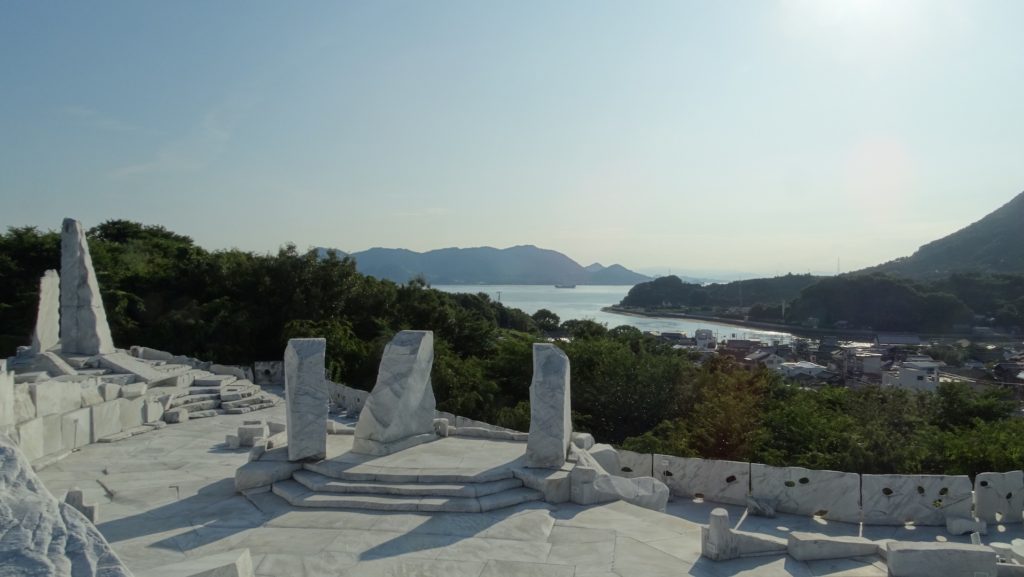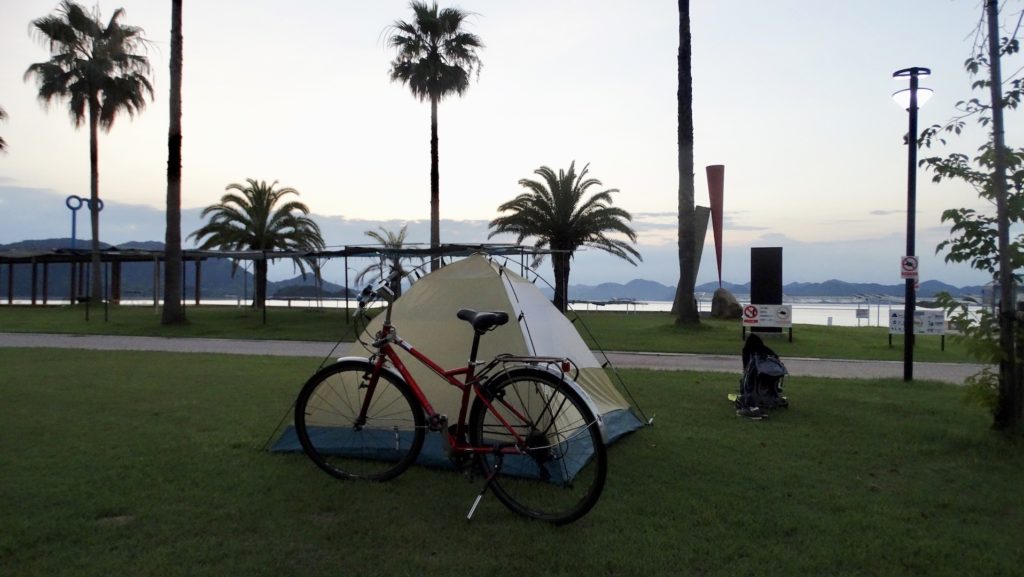PEDDLING PERFECTION: CYCLING THE SHIMANAMI KAIDO ROUTE, PART 2

The first stop on the Shimanami is the jetty in Onomichi where you get a ferry the short distance to Mukaishima: the first island and the start of the route proper. As the sun was getting lower towards late afternoon the vicious heat also began to dissipate. I was making a habit of travelling to parts of Asia during the hottest part of the year. I’d already ticked off some fearsome temperatures in Burma and now I was taking on Japan.
Kosanji Temple and Italian Marble
I had read something about a temple with nice views, the latter being of more interest. So, I paid for the right and then erected my tent on a sports field by Setoda ’Sunset’ Beach. Next, I got back back on my bike and headed for Kosanji Temple. I paid the entrance fee and made my way directly past the temple, being careful to avoid it altogether. The reason for this was a combination of temple fatigue and nice view favouritism. Not that I don’t like temples, or that temples and nice views can’t go hand in hand. But if I have to choose between them, I would always go for the views, a bit like savoury food over sweet or BBC Radio 4 over 6 Music.
Actually, the last example is questionable because I wouldn’t listen to two radio stations simultaneously. Unless, I timed it so that whilst they’re reading the news on Radio 4, they’re playing breakbeat hardcore on 6 music. That might be interesting, but it’s also irrelevant to the rest of this post.
I reached the top of the hill in the temple grounds and marvelled at what was in front of me. A large area of marble steps, platforms and sculptures with stunning panoramic views of the Seto Sea and its many islands. It’s called Miraishin no Oka which translates as Heights of Eternal Hope for the Future. I’m not sure if ‘eternal hope’ is desperate or wildly optimistic; however, that discussion is for another day, in the future, hopefully. Anyway, it turns out that the engineers imported the marble entirely from Italy and the structure has no spiritual connection to the temple. Or, seemingly, any other kind of historical or cultural meaning; it’s just a beautifully crafted artistic endeavour. Lovely.
Camping in Hot Weather
Camping in the heat of the Japanese summer comes with some challenges. Actually, mainly just one: the unrelenting and oppressive heat. As I was in a public area, I couldn’t camp without outer layer of the tent, which is usually protects you from the elements. However, in hot climates the outer layer acts as an accelerant, and in this case, prevents passers by from seeing my semi-clothed form submerged in a domed paddling pool of perspiration. At sunrise, I fought my way out of my prison, through an impenetrable sequence of zips, ’doors’ and fly sheets. I promptly ran into the sea, and luxuriated in the cool water lapping around me, wondering how day two on Shimanami would pan out.

The Final Bridge of Shimanami
My second day followed a fairly similar pattern: magnificent views, mediocre photos and ingenious infrastructure. Some of the bridges have two tiers, one each for vehicles and bikes. Others have separate approach and exit roads for bikes, which are a bit like tarmac water slides that you weave your way up or down, singing at the top of your voice.
However, the best bridge comes at the end. The Kurushima Kaikyo Bridge is the longest suspension bridge structure in the world and stretches for 2.5 miles, connecting Oshima island with the main island of Shikoku and the finish line of the Shimanami Kaido route. It was completed in 1999 and took 9 years to construct. It actually consists of three successive bridges, 6 towers, 4 anchorages and many other less interesting facts.
I decided not to refill my water bottle at one of the drinking fountains on the approach to the bridge. I’m not sure whether this was borne out of a subconscious need to give myself a final challenge, or naivety about the remaining distance. Regardless, it certainly made me appreciate the enormity of the structure and the precious saliva in my mouth.
How Long Should it Take?
The Shimanami Kaido route should be a pilgrimage for any cyclist or cyclist loathing driver. It is a shining example of Japanese pragmatism, engineering prowess and their boundless appreciation of simple leisure activities.
As I was returning my bike in Imabari around 3pm, I met a Japanese couple who were setting out in the opposite direction. I eulogised about my experience, but warned them of the heat and need to take plenty of liquids on board. They calmly and kindly informed me that they were triathletes and were planning to do the entire route that afternoon. This made me want to pour my energy drink over their heads and rub salted peanuts in their eyes. But, honestly, I can only admire their superior conditioning. If I do the route again in the future, which I hope I will, I’ll take 4 days.